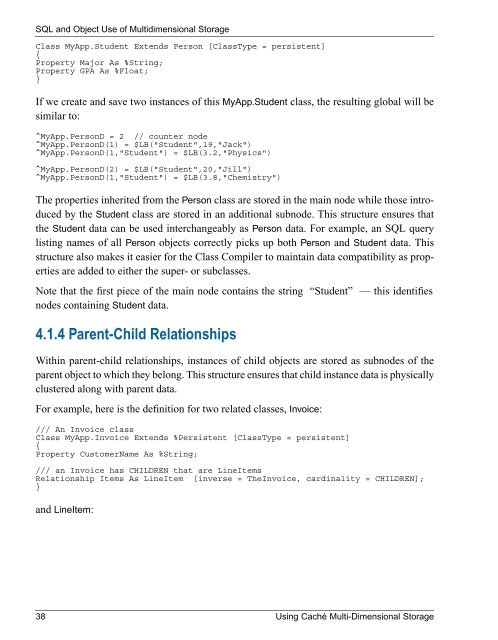Using Caché Multi-Dimensional Storage - InterSystems ...
Using Caché Multi-Dimensional Storage - InterSystems ...
Using Caché Multi-Dimensional Storage - InterSystems ...
You also want an ePaper? Increase the reach of your titles
YUMPU automatically turns print PDFs into web optimized ePapers that Google loves.
SQL and Object Use of <strong>Multi</strong>dimensional <strong>Storage</strong><br />
Class MyApp.Student Extends Person [ClassType = persistent]<br />
{<br />
Property Major As %String;<br />
Property GPA As %Float;<br />
}<br />
If we create and save two instances of this MyApp.Student class, the resulting global will be<br />
similar to:<br />
^MyApp.PersonD = 2 // counter node<br />
^MyApp.PersonD(1) = $LB("Student",19,"Jack")<br />
^MyApp.PersonD(1,"Student") = $LB(3.2,"Physics")<br />
^MyApp.PersonD(2) = $LB("Student",20,"Jill")<br />
^MyApp.PersonD(1,"Student") = $LB(3.8,"Chemistry")<br />
The properties inherited from the Person class are stored in the main node while those introduced<br />
by the Student class are stored in an additional subnode. This structure ensures that<br />
the Student data can be used interchangeably as Person data. For example, an SQL query<br />
listing names of all Person objects correctly picks up both Person and Student data. This<br />
structure also makes it easier for the Class Compiler to maintain data compatibility as properties<br />
are added to either the super- or subclasses.<br />
Note that the first piece of the main node contains the string “Student” — this identifies<br />
nodes containing Student data.<br />
4.1.4 Parent-Child Relationships<br />
Within parent-child relationships, instances of child objects are stored as subnodes of the<br />
parent object to which they belong. This structure ensures that child instance data is physically<br />
clustered along with parent data.<br />
For example, here is the definition for two related classes, Invoice:<br />
/// An Invoice class<br />
Class MyApp.Invoice Extends %Persistent [ClassType = persistent]<br />
{<br />
Property CustomerName As %String;<br />
/// an Invoice has CHILDREN that are LineItems<br />
Relationship Items As LineItem [inverse = TheInvoice, cardinality = CHILDREN];<br />
}<br />
and LineItem:<br />
38 <strong>Using</strong> <strong>Caché</strong> <strong>Multi</strong>-<strong>Dimensional</strong> <strong>Storage</strong>

















